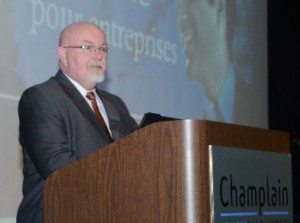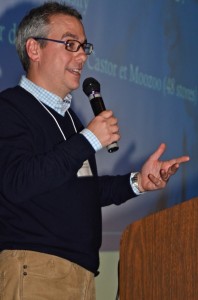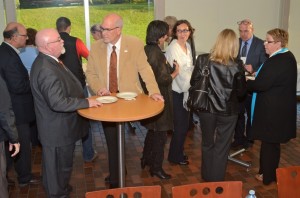For the second consecutive year, RAC candidates and
Champlain students studying towards their
Transportation and Logistics AECs have participated in a unique set of classes held at the
Port of Montreal. The initiative was the brainchild of Yves Gilson, Director of Communications at the Port, and
Peter Raimondo, logistics instructor at Champlain College Saint-Lambert. Held on November 5
th and 6
th 2012, the classes featured presentations by representatives of the Port of Montreal and many of its partners, as well as executives from the transportation community. The event also included an exclusive bus tour of the Port, and an industrial tour of
Lantic Sugar (situated on the Port’s property).
The presentations formed a comprehensive profile of the Port through a variety of topics, and helped clarify how it interacted with other parties. Tony Boemi, Vice President of Growth and Development, kicked off the event by speaking about the challenges of receiving global traffic and the effectiveness of moving merchandise through the port of Montreal – whether by rail, truck, or by ship.

The miniature model served as a valuable visual aid during presentations.
Stefan Routhier, Deputy Harbour Master, and Stéphane Brabant explained the operations and rail services on the Port property by using a fascinating miniature model of an impressive scale. Routier also described an ongoing effort to build special access ramps to Autoroute 25, an initiative designed to reduce local traffic while reducing lost time. He also discussed past initiatives that were proven successful, such as a finger-print based authentication system that allowed truckers to get verified faster than before.
The Port’s Director of Security highlighted the various procedures utilized by the Port, such as the use of tracking devices in containers. These devices, he explained, were useful beyond their immediate security benefits – they also allowed the Port to track movement patterns, and in turn, opportunities to improve. To cover their 78 acres of immediate territory and that of their connected terminals, the Port uses fencing and more than 250 cameras to monitor areas in real-time. The Port also has its own onsite security personnel, fire unit, and HAZMAT response team, and is able to resolve most problems that occur within its own territory. For everything else, they utilize and cooperate with the Montreal Police and Fire departments. To ensure 24/7 availability of its services, the Port’s control center and core services feature multiple layers of automatic fail-safes that allow it to remain operational even in the presence of multiple malfunctions. The Director’s presentation served as an important reminder that security is a significant concern for clients.

The bus tour allowed students and candidates to learn about the Port and its associated intricacies.
Lyne Martin, Director of Environment at the Port of Montreal offered insight into how the Port maintained sustainable operations, including numerous initiatives that reduce pollution and other environmental threats. It was clear that the Port took these matters quite seriously, and helped establish the many factors that are considered by modern players in transport and logistics.
There were also speakers from the
Canada Border Services Agency: Valérie-Anne Côté, and France Bolduc – who covered the need and the process of the ADI (advance information system) that requires carriers and forwarders to provide cargo information 24-hours prior to loading onboard a ship at the port of export. They also explained the step-by-step custom clearance procedure for import cargoes.
The second day consisted of three executives (Kevin Doherty, Christian Siviere and Daniel Falaise) from the Transportation community, who spoke about:
- The strategies employed at a container terminal and how they plan the loading and stowage of containers on board container ships.
- The role and responsibilities of freight forwarding.
- The functions of a conventional marine terminal and the vocabulary used in conventional shipping commerce.
Altogether, the presentations provided attendees with a thorough understanding of how a modern port functions, and allowed them to ask questions throughout.

Lantic’s management of its sugar stockpile was particularly impressive.
The tour that followed then allowed candidates and students to see the various technologies that were discussed throughout the day. The result was a shared realization that the Port of Montreal was a leader in its field – with solid procedures and modern technology at every corner. Most importantly, the outing provided RAC candidates and Champlain students with a real-life example of how logistics are handled in a Quebec. Furthermore, the Lantic sugar tour allowed participants to witness how a specific company interacted with the Port of Montreal in its operations.
Here’s what some of the RAC candidates had to say about the event:
“J’ai beaucoup aimé recevoir des informations détaillées et pratiques, venant d’intervenants expérimentés. Tout cela m’a permis de mieux comprendre le fonctionnement du Port de Montréal et de voir à quel moment chaque acteur interne et externe entre en jeu. En tant que professionnelle de la logistique, c’est agréable de savoir qu’on peut compter sur une institution d’envergure pour faciliter nos activités commerciales.”
“La visite du port nous a permis de mettre en pratique certaines choses que nous connaissions ou que nous avons vu dans nos cours, c’est impressionnant, de plus les présentations étaient représentatives et reliées directement au sujet, une très bonne diversification de sujets et d’intervenant.”
Since the launch of
Mentorship+, project leader
Anna Maria Zaidman has been working with numerous mentors and mentees in developing their mentoring relationships. Part of this effort involves training the involved parties in their respective roles. To do this, Zaidman recently announced a two-part training session for mentors. The first part of this event was held on January 17th, 2013, and proved valuable for the attending parties.

The second session is scheduled to occur on
Thursday, January 24th, 2013, and will conclude the two-part training sessions for mentors. To participate in the training sessions, attendees must first be registered to participate in Champlain College’s
Mentorship+ program. The program is available to students of Champlain College’s Continued Education department, as well as RAC candidates. In the second part of this session, Zaidman will cover the following topics:
- Understanding personality differences in the workplace.
- Understanding cultural differences in the workplace.
- Cross-cultural communication.
- Listening skills.
- Questioning skills.
- Ethics in Mentoring.
She also announced a training session specifically for mentees, scheduled for
Thursday, January 31st, 2013 from
6:30pm to
9:30pm. The event is open to all mentees who are registered through the Mentorship+ program; to attend,
mentees must simply fill out a short registration form. The topics planned for the evening include:
- Mentee’s expectations and mentor’s role.
- Mentee role and responsibilities.
- Quebec work culture.
- Organizational culture.
- Cross-cultural communication.
- Confidentiality and boundaries of the relationship.
If you’re interested in learning more about our Mentorship+ initiative, you may
read about it on our website, or contact
Anna Maria Zaidman directly. Those who have recently immigrated may also find
one of our recent blog posts interesting, as it highlights the efforts taken by our team to make Mentorship+ cater to their challenges.
On September 24th, we officially launched our
new RAC services for businesses, including our
Applied Business Development (ABD) program. The event was held at Champlain College’s Saint Lambert campus, and was host to more than 50 guests, including numerous business representatives. Among them were some of our partners: the MDEIE, the Pôle d’excellence québécois en transport terrestre, Emploi-Québec, Camo-Route, and CEDEC – all of whom were instrumental in the development and release of the RAC services for businesses.

The evening started with introductory addresses by both Don Shewan, Director of the Saint-Lambert campus, and Mark Wallace, Director of Continuing Education. Shewan noted the following:
“Our Recognition of Acquired Competencies (RAC) process formally recognizes and validates employee work and life experience through a rigorous recognition and training process. We’ve made every effort to render it as accessible as possible to today’s busy business people.”
He later went on to mention that Champlain College had already invested more than half a million dollars into RAC, and is devoted to its success, growth, and positive influence it has on the community. Wallace announced that since Champlain started offering RAC services in 2009, more than 400 people from a wide variety of backgrounds and expertise had used the RAC services.
Isabelle Stébenne then described the specific features of the Applied Business Development program, including an overview of the competencies, and the available evaluation options. She explained that the services were designed with busy people in mind, with offerings such as on-site evaluations and training, as well as a flexible schedule that includes weeknights and weekends. The result? Enhanced employee productivity, competency, and retention with little to no impact on the candidate’s work schedules.
The next speaker was Stacey Dakin, who spoke on behalf of CEDEC, the
Community Economic Development and Employability Corporation. CEDEC offers support to small businesses across Quebec, and are looking to give their clients a way to acquire official certifications through their workshops, in partnership with RAC. CEDEC also helped develop course content and promote the program throughout the province of Québec.

Stébenne then returned to introduce the specialists who were bringing their expertise to the ABD program, all of whom have backgrounds rooted in real industry experience and academic training. She was soon followed by Geneviève Rock, RAC Coordinator, who highlighted
Raymond Patry and Richard Vachon as the official liasons for businesses which are seeking RAC services. Patry and Vachon are both from the industry, and conveyed an understanding of how great the needs were. They mentioned how pleased they were to be working closely with businesses to help them find realistic, compatible solutions.
Rock then introduced Anna Maria Zaidman, who is working with companies to support the successful integration of immigrants. The RAC services are designed to address the specific needs of immigrants, and use a combination of training, placement assistance, and mentorship to achieve positive results. By assigning a mentor that is internal to an organization, RAC helps prevent conflicts that originate from a lack of knowledge about cultural differences, thereby increasing retention. Language training is also offered to the candidates that need it, further improving their ability to adapt to the Quebec workplace.

Well-known entrepreneur and Champlain College alumni
Pino Di Ioia also took the podium to announce his support for the RAC services. Di Ioia is the co-founder of Moozoo® and CEO of BeaverTails®, the latter having a total of 117 stores. In addition to running his businesses, Di Ioia serves as a content specialist for RAC’s ABD program.
Jana Sharock then took the stage to describe the
Transport and Logistics services offered through RAC for Businesses. She was soon followed by Jean Simard of the
Pôle d’excellence québécois en transport terrestre, which, along with the MDEIE’s financing, helped make the RAC services available in Québec. Simard mentioned a growing need for transportation and logistics workers in Québec, particularly with the coming changes to Québec’s autoroute 30. He highlighted the importance of training in the industry, with a specific emphasis on Québec’s industrial climate and needs.
Sharock then returned to describe the dispatching services offered to businesses. She explained that the AEC was created to meet a growing need for dispatchers in the industry. The initiative led to a joint-project being created with Camo-Route, and it also resulted in numerous businesses approaching RAC. A key feature of the program involves taking candidates who are already knowledgeable about the industry, training them four days a week, and then having them be mentored by a present dispatcher on the fifth day.
Mario Sabourin (of
Camo-Route) soon followed, and emphasized Simard’s concerns, as Camo-Route’s surveys revealed that Québec had a shortage of 3,000 transport and logistics workers.

Eric Poehlman wrapped up the presentation by offering a brief introduction to the
Information Technology Support Specialist (ITSS) program offered through RAC. He noted the importance of IT skills in the industry and the need to train individuals in this area. He also hinted at future directions, including RAC programs in CISCO and Social Media.
Attendees were then invited to a reception party that featured a wide range of cocktails and catered food. The party served as a good networking opportunity, while also allowing guests to find out more about the programs from the content specialists themselves. Don Shewan and Kenneth J. Robertson, Director General, were also in attendance.
The launch event was a success, and it also motivated several individuals to register for RAC services immediately following the presentation. If you missed the event, please feel free to step through the presentation and photos, both of which are included below.
PowerPoint: Launch Presentation
-

-

-
Pictured: Don Shewan
-

-

-
Pictured: Don Shewan
-

-
Pictured: Mark Wallace
-

-
Pictured: Eric Poehlman
-

-
Pictured (left to right): Mark Wallace, Kenneth Robertson, Genevieve Rock, Isabelle Stebenne, Carole Arsenault, Bart Kasowski, Don Shewan.
-

-
Pictured (left to right): Jean Simard from the Pole, Denis Legault from Camo-Route, Stacy Dakin from CEDEC, Mario Sabourin from Camo-Route, Genevieve Rock, Mark Wallace, Don Shewan.
-



 The evening started with introductory addresses by both Don Shewan, Director of the Saint-Lambert campus, and Mark Wallace, Director of Continuing Education. Shewan noted the following:
The evening started with introductory addresses by both Don Shewan, Director of the Saint-Lambert campus, and Mark Wallace, Director of Continuing Education. Shewan noted the following:
 Stébenne then returned to introduce the specialists who were bringing their expertise to the ABD program, all of whom have backgrounds rooted in real industry experience and academic training. She was soon followed by Geneviève Rock, RAC Coordinator, who highlighted Raymond Patry and Richard Vachon as the official liasons for businesses which are seeking RAC services. Patry and Vachon are both from the industry, and conveyed an understanding of how great the needs were. They mentioned how pleased they were to be working closely with businesses to help them find realistic, compatible solutions.
Rock then introduced Anna Maria Zaidman, who is working with companies to support the successful integration of immigrants. The RAC services are designed to address the specific needs of immigrants, and use a combination of training, placement assistance, and mentorship to achieve positive results. By assigning a mentor that is internal to an organization, RAC helps prevent conflicts that originate from a lack of knowledge about cultural differences, thereby increasing retention. Language training is also offered to the candidates that need it, further improving their ability to adapt to the Quebec workplace.
Stébenne then returned to introduce the specialists who were bringing their expertise to the ABD program, all of whom have backgrounds rooted in real industry experience and academic training. She was soon followed by Geneviève Rock, RAC Coordinator, who highlighted Raymond Patry and Richard Vachon as the official liasons for businesses which are seeking RAC services. Patry and Vachon are both from the industry, and conveyed an understanding of how great the needs were. They mentioned how pleased they were to be working closely with businesses to help them find realistic, compatible solutions.
Rock then introduced Anna Maria Zaidman, who is working with companies to support the successful integration of immigrants. The RAC services are designed to address the specific needs of immigrants, and use a combination of training, placement assistance, and mentorship to achieve positive results. By assigning a mentor that is internal to an organization, RAC helps prevent conflicts that originate from a lack of knowledge about cultural differences, thereby increasing retention. Language training is also offered to the candidates that need it, further improving their ability to adapt to the Quebec workplace.
 Well-known entrepreneur and Champlain College alumni Pino Di Ioia also took the podium to announce his support for the RAC services. Di Ioia is the co-founder of Moozoo® and CEO of BeaverTails®, the latter having a total of 117 stores. In addition to running his businesses, Di Ioia serves as a content specialist for RAC’s ABD program.
Jana Sharock then took the stage to describe the Transport and Logistics services offered through RAC for Businesses. She was soon followed by Jean Simard of the Pôle d’excellence québécois en transport terrestre, which, along with the MDEIE’s financing, helped make the RAC services available in Québec. Simard mentioned a growing need for transportation and logistics workers in Québec, particularly with the coming changes to Québec’s autoroute 30. He highlighted the importance of training in the industry, with a specific emphasis on Québec’s industrial climate and needs.
Sharock then returned to describe the dispatching services offered to businesses. She explained that the AEC was created to meet a growing need for dispatchers in the industry. The initiative led to a joint-project being created with Camo-Route, and it also resulted in numerous businesses approaching RAC. A key feature of the program involves taking candidates who are already knowledgeable about the industry, training them four days a week, and then having them be mentored by a present dispatcher on the fifth day.
Mario Sabourin (of Camo-Route) soon followed, and emphasized Simard’s concerns, as Camo-Route’s surveys revealed that Québec had a shortage of 3,000 transport and logistics workers.
Well-known entrepreneur and Champlain College alumni Pino Di Ioia also took the podium to announce his support for the RAC services. Di Ioia is the co-founder of Moozoo® and CEO of BeaverTails®, the latter having a total of 117 stores. In addition to running his businesses, Di Ioia serves as a content specialist for RAC’s ABD program.
Jana Sharock then took the stage to describe the Transport and Logistics services offered through RAC for Businesses. She was soon followed by Jean Simard of the Pôle d’excellence québécois en transport terrestre, which, along with the MDEIE’s financing, helped make the RAC services available in Québec. Simard mentioned a growing need for transportation and logistics workers in Québec, particularly with the coming changes to Québec’s autoroute 30. He highlighted the importance of training in the industry, with a specific emphasis on Québec’s industrial climate and needs.
Sharock then returned to describe the dispatching services offered to businesses. She explained that the AEC was created to meet a growing need for dispatchers in the industry. The initiative led to a joint-project being created with Camo-Route, and it also resulted in numerous businesses approaching RAC. A key feature of the program involves taking candidates who are already knowledgeable about the industry, training them four days a week, and then having them be mentored by a present dispatcher on the fifth day.
Mario Sabourin (of Camo-Route) soon followed, and emphasized Simard’s concerns, as Camo-Route’s surveys revealed that Québec had a shortage of 3,000 transport and logistics workers.
 Eric Poehlman wrapped up the presentation by offering a brief introduction to the Information Technology Support Specialist (ITSS) program offered through RAC. He noted the importance of IT skills in the industry and the need to train individuals in this area. He also hinted at future directions, including RAC programs in CISCO and Social Media.
Attendees were then invited to a reception party that featured a wide range of cocktails and catered food. The party served as a good networking opportunity, while also allowing guests to find out more about the programs from the content specialists themselves. Don Shewan and Kenneth J. Robertson, Director General, were also in attendance.
The launch event was a success, and it also motivated several individuals to register for RAC services immediately following the presentation. If you missed the event, please feel free to step through the presentation and photos, both of which are included below.
PowerPoint: Launch Presentation
Eric Poehlman wrapped up the presentation by offering a brief introduction to the Information Technology Support Specialist (ITSS) program offered through RAC. He noted the importance of IT skills in the industry and the need to train individuals in this area. He also hinted at future directions, including RAC programs in CISCO and Social Media.
Attendees were then invited to a reception party that featured a wide range of cocktails and catered food. The party served as a good networking opportunity, while also allowing guests to find out more about the programs from the content specialists themselves. Don Shewan and Kenneth J. Robertson, Director General, were also in attendance.
The launch event was a success, and it also motivated several individuals to register for RAC services immediately following the presentation. If you missed the event, please feel free to step through the presentation and photos, both of which are included below.
PowerPoint: Launch Presentation
You must be logged in to post a comment.